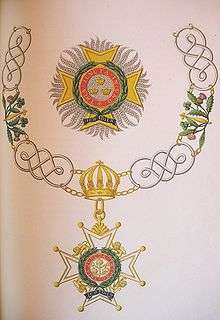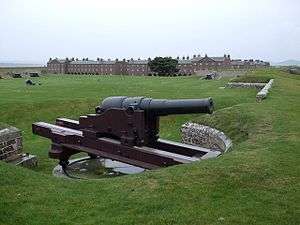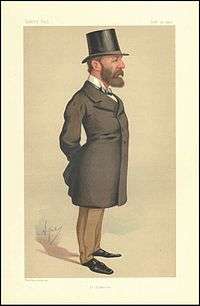Richard Taylor (British Army officer)
General Sir Richard Chambré Hayes Taylor GCB (19 March 1819 – 6 December 1904) was a senior British Army officer who served in the Second Anglo-Burmese War, the Crimean War and the Indian Mutiny. Joining the General Staff in 1860, he was the British Army's Inspector General of Recruiting, then Deputy Adjutant-General to the Forces, briefly Adjutant-General, and finally for three years Governor of the Royal Military College, Sandhurst. He was also Colonel of the Queen's Own Cameron Highlanders and the East Surrey Regiment.
Sir Richard Chambré Hayes Taylor | |
|---|---|
 Insignia of a Knight Grand Cross of the Order of the Bath (military) | |
| Born | 19 March 1819 Dublin, Ireland |
| Died | 6 December 1904 (aged 85) |
| Allegiance | |
| Service/ | |
| Rank | General |
| Commands held | Queen's Own Cameron Highlanders Fort George, Scotland Royal Military College, Sandhurst |
| Battles/wars | Second Anglo-Burmese War Crimean War (Alma, Balaclava and Sebastopol) Indian Mutiny (Lucknow) |
| Awards | CB, 1857; KCB, 1882; GCB, 1902. |
Some members of the family preferred the spelling Taylour.
Early life
Born in Dublin in 1819, Taylor was a younger son of the Hon. and Rev. Henry Edward Taylor (1768–1852) by his marriage in 1807 to Marianne, a daughter of Colonel Richard St Leger, second son of St Leger, 1st Viscount Doneraile (died 1787).[1] Taylor's father was the fifth son of Thomas Taylor, 1st Earl of Bective, and was a younger brother of the first Marquess of Headfort,[2] and he also had two other brothers, General Robert Taylour and Clotworthy Rowley, 1st Baron Langford (1763–1825), and a sister, Henrietta.[3]
Taylor was himself one of three sons and four daughters. His older brother, Thomas Edward, born in 1811, joined the 6th Dragoon Guards, while his younger brother, Hercules Langford Barry, born in 1824, died in 1833. Their sisters were Marianne Jane (born 1809), Elizabeth Augusta Anne (1812), Louisa Catherine (1815) and Henrietta Frances (1817).[3] Taylor was educated at Hazelwood School and the Royal Military College, Sandhurst.[4][5]
Military career
Taylor was commissioned as an ensign into the British Army's 79th Foot on 11 December 1835.[6] On 29 March 1839 he was promoted Lieutenant[7] and on 23 August 1844 Captain.[8] During his early career he served both at home and overseas. In 1852 and 1853 he fought with the 18th Royal Irish in the Second Anglo-Burmese War.[9] During the Crimean War he was part of the force on active service in the Crimea, from 1854 to 1855.[10] On 12 December 1854 he was promoted lieutenant colonel,[10] confirmed on 9 March 1855,[11] and commanded the 79th Cameron Highlanders as part of the Highland Brigade. He fought with his regiment at the Battles of Alma and Balaclava and at the Siege of Sebastopol, at which he was mentioned in despatches.[10] At Sebastopol, he commanded the Royal Artillery of the Highland Division.[12] From 1856 to 1857, Taylor was in command of the Fort George Depot Battalion near Inverness.[10][13][14] He next served with the 79th in India, from 1857 to 1859, and was there during the Mutiny. In command of the 79th, he took part in the Capture of Lucknow in March 1858.[15] He commanded a brigade in Oude from November 1858 to January 1859.[16] In 1860 he joined the General Staff in England, then held a variety of posts, in the course of which he was promoted major general on 6 March 1868, lieutenant general on 23 August 1877, and finally general on 30 January 1880.[10]

In 1862, Taylor was assistant adjutant general for the British Army Division at Shorncliffe and Dover.[17] In 1873, he was appointed as the Army's Inspector General of Recruiting.[18] He remained in this post until 1876, when he was appointed as Deputy Adjutant-General to the Forces.[19] In 1882, Taylor took over the role of adjutant-general while Sir Garnet Wolseley was overseas in command of British forces during the Second Anglo-Egyptian War of 1882.[20] His last posting, as governor of the Royal Military College, Sandhurst, was effective from 1 January 1883[21] and lasted until 1886, when he retired the service.[4]
In 1876, Taylor was chairman of the Royal United Services Institute.[22] From 1887 until his death, he was Colonel of the Queen's Own Cameron Highlanders, in which role he was succeeded by General Sir Ian Hamilton.[10][23] He was also Colonel of the 2nd Battalion the East Surrey Regiment.
Taylor was appointed a Knight Grand Cross of the Order of the Bath (GCB) in the 1902 Coronation Honours list published on 26 June 1902,[24][25] and was invested by King Edward VII at Buckingham Palace on 8 August 1902.[26]
Private life

Taylor's elder brother, Thomas Edward Taylor, of Ardgillan Castle, Dublin, became member of parliament for County Dublin, Chancellor of the Duchy of Lancaster, and Commandant of the Royal Meath Militia.[27] Taylor's father died in 1852 and his mother on 22 March 1859.[28] The Rev. James Aberigh Mackay met Taylor in India in 1859 and later wrote of him in From London to Lucknow (1860): "Colonel Taylor of the 79th, one of the most agreeable men in the army..."[29]
On 10 June 1863, Taylor married Lady Jane Hay, a daughter of Field Marshal the Marquess of Tweeddale. They had one son and four daughters. In 1872, they were living at number 16, Eaton Place, Westminster.[30] Taylor also owned some 1,300 acres of land in County Meath, Ireland.[31] Lady Jane Taylor survived her husband until 1920.[4][5]
Taylor's brothers-in-law included Arthur Hay, 9th Marquess of Tweeddale, Admiral of the Fleet Lord John Hay, and the Liberal member of parliament George Hay, Earl of Gifford, while his sisters-in-law were married to James Broun-Ramsay, 1st Marquess of Dalhousie, a Governor-General of India, Arthur Wellesley, 2nd Duke of Wellington, Sir Robert Peel, 3rd Baronet, and Simon Watson Taylor, of Erlestoke, Wiltshire.[5] Taylor's five children were Constance Mary Jane (married Ronald William Murray, died 1950), Millicent Lilla Harriet (born 1867 died 1948), Evelyn Beatrice Charlotte (died 1944 unmarried), Florence Virginia Mathilde (died 1952 unmarried) and Richard Edward Montagu Taylor (1872–1953).[32] His son Richard joined the East Surrey Regiment and fought in the Second Boer War and the First World War.[33]
Publications
- R. C. H. Taylor, The Queen's Own Cameron Highlanders: standing orders (1897)[34]
References
- George Washington Moon, Men and Women of the Time, Part Two (2005 reprint), p. 874: "TAYLOR, General Sir Richard Chambre Hayes, KCB, born in Dublin, March 10, 1819, second son of the Hon. and Rev. Edward Taylor, younger son of the First Earl of Bective, by Marianne, daughter of Colonel the Hon. Richard St Leger..."
- John Debrett, Debrett's Peerage of England, Scotland, and Ireland, vol. 2 (1825), p. 864: "Edward, in holy orders, b. 13 Nov. 1768, m., 10 May 1807, Marianne St. Leger, eldest da. of the hon. Richard St. Leger, 2d son of viscount Doneraile..."
- John Burke, Dictionary of the Peerage & Baronetage of the British Empire (6th edition, 1839), p. 521
- 'Taylor, Sir Richard Chambré Hayes (born 19 March 1819, died 6 Dec. 1904)' in Who Was Who 1897–1915 (London: A. & C. Black, 1988 reprint: ISBN 0-7136-2670-4)
- Marquis of Tweeddale at cracroftspeerage.co.uk, accessed 22 July 2011
- London Gazette, Issue 19337 published 11 December 1835, p. 2476
- Hart's annual army list, militia list, and imperial yeomanry list (1845), p. 231
- London Gazette Issue 20376 published 23 August 1844, p. 2933
- Hart's annual Army list, Militia list, and Imperial Yeomanry list (1868), p. 124
- John Percy Groves, History of the 79th Queen's Own Cameron Highlanders, now the first battalion Queen's Own Cameron Highlanders, 1794-1893 (W. & A. K. Johnston, 1893), p. 23: "Sir Richard Chambre Hayes Taylor, KCB Appointed 9th September 1887. Ensign 79th Highlanders, 11th December 1835 ; Lieutenant, 29th March 1839 ; Captain, 23rd August 1844 ; Major, 8th August 1854; Lieutenant-Colonel, 12th December 1854; Depot Battalion, 1st October 1856; 79th, 17th July 1857; Depot Battalion, 4th May 1860; half-pay, 17th July 1860; Brevet-Colonel, 21st May 1858; Major-General, 6th March 1868; Lieutenant-General, 23rd August 1877 ; General, 30th January 1880 ; Colonel, 79th Queen's Own Cameron Highlanders, 1st January 1879... Governor of the Royal Military College, 1st January 1883. Served with the 79th Highlanders throughout the Crimea, 1854-55 (a short interval, between 9th February and 15th June 1855, excepted) including battles of Alma and Balaklava, and siege of Sebastopol (mentioned in despatches, medal with three clasps, Turkish medal, and 5th Class of the Medjidie)"
- London Gazette, Issue 21674 published 9 March 1855, p. 1007
- H. G. Hart, The new army list and militia list (1858), p. 290: "Colonel Taylor served at the siege and fall of Sebastopol in 1855 in command of the Artillery of the Highland Division (Medal and Clasp, and 5th Class of the Medjidie)."
- Historical records of the 72d Highlanders (1886), p. 83: "The four depot companies of the 72d were ordered from Paisley to Fort George, to be formed into a battalion, together with those of 71st and 92d Highlanders, to be commanded by Lieutenant-Colonel Taylor..."
- Oliver and Boyd's new Edinburgh almanac and national repository (1857), p. 617: "DEPOT BATTALIONS... FORT GEORGE Lieut.-Colonel, R. C. H. Taylor"
- Robert Jameson, Historical records of the 79th Queen's Own Cameron Highlanders (Hamilton, Adams, 1887), p. 142
- Hart's annual Army list, Militia list, and Imperial Yeomanry list (1861), p. 60: "Colonel Taylor... Commanded the 79th Highlanders from Feb. to 16th Nov. 1858 in the Indian campaign, including the siege and capture of Lucknow, and commanded a Brigade in Oude from Nov. 1858 to Jan. 1859. "
- Hart's annual Army list, Militia list, and Imperial Yeomanry list (1862), p. 469
- colonel H. G. Hart, The New Army List, Militia List and Indian Civil Service List (1874), p. 263: "Inspector General of Recruiting Major General RCH Taylor, CB. 1 Aug. 73."
- London Gazette published 28 November 1876, p. 6532
- Arthur William Alsager Pollock, The United service magazine (1882), p. 102: "The Adjutant-Generalship. – The appointment of Lieutenant- General R. C. H. Taylor, C.B., to officiate as Adjutant-General to the Forces, during the absence of Sir Garnet Wolseley on special service, is one that cannot fail to afford much satisfaction to the army."
- London Gazette, Issue 25178 published 15 December 1882, p. 6392
- Journal of the Royal United Service Institution, vol. 19 (1876), p. 399
- London Gazette, Issue 27768 published 24 February 1905, p. 1397
- "The Coronation Honours". The Times (36804). London. 26 June 1902. p. 5.
- "No. 27448". The London Gazette (Supplement). 26 July 1902. pp. 4189–4190.
- "Court Circular". The Times (36842). London. 9 August 1902. p. 6.
- Edmund Lodge, Anne Innes, The peerage and baronetage of the British empire as at present existing (1860), p. 299
- John Burke, Burke's Peerage and Baronetage 1865, p. 563
- James Aberigh Mackay, From London to Lucknow: with memoranda of mutinies, marches, flights, fights, and conversations : to which is added, an opium-smuggler's explanation of the Peiho massacre, vol. 2 (James Nisbet and Co., 1860), p. 399: "Colonel Taylor of the 79th, one of the most agreeable men in the army, dined at mess this evening. The last time I saw him was at the Ardersier station of the Nairn Railroad. He was then commanding at Fort-George."
- London Gazette Issue 23833 (Supplement) published 29 February 1872, p. 1232
- Jean Rice, County Meath: Landowners (1999): "Gen. Richard C. H. Taylor, address Ardgillan Castle, Balbriggan, owned 1,304 acres."
- Lundy, Darryl. "General Sir Richard Chambre Hayes Taylor". The Peerage. Retrieved 24 July 2011.
- Lundy, Darryl. "Richard Edward Montagu Taylor". The Peerage. Retrieved 24 July 2011.
- The Queen's Own Cameron Highlanders: publication details at books.google.com, accessed 22 July 2011
External links
- BC 1120 LT. GENERAL SIR RICHARD TAYLOR LETTERS at University of Cape Town Libraries Manuscripts & Archives
| Military offices | ||
|---|---|---|
| Preceded by Sir Garnet Wolseley |
Adjutant General 1882 |
Succeeded by Sir Garnet Wolseley |
| Preceded by Major-General William Napier |
Governor of the Royal Military College Sandhurst 1883–1886 |
Succeeded by General David Anderson |